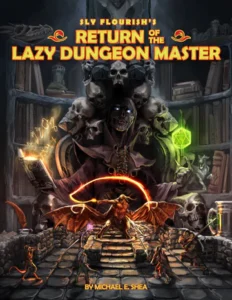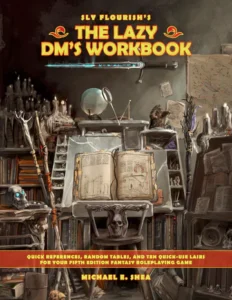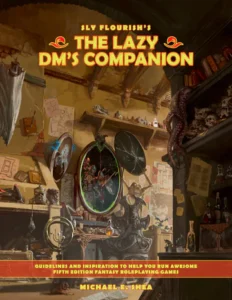by Jason Campbell
NOTE: No products or money were provided in exchange for this review.
Mike Shea has been writing books under the umbrella of Sly Flourish’s Lazy Dungeon Master for a decade. These books are tools for game masters to become better at their craft. Although they often reference Dungeons & Dragons they are just as useful for any d20 based game and even other sorts of TTRPGs. Here we’ll review several of these books, which are available from the Sly Flourish store or through Drive Thru RPG
The Lazy Dungeon Master
This first book in the series established the themes of the coming book: making it easier to prep TTRPG sessions with advice and resources. This book is no longer available on the Sly Flourish store, as the following book, Return of the Lazy Dungeon Master revamps and revisits the ideas presented here. If you’re new to this series you can skip this book and begin with the following book.
Return of the Lazy Dungeon Master

This book sets the standard of the series. Its tools are designed to make preparation for game masters easier. The book follows the general idea that game masters are better off preparing only a session or so ahead of the current game, as players are likely to make choices you aren’t prepared for which could leave in depth long term planning unused. Chapter 2 begins by introducing the Dungeon Master’s checklist, often referred to as the “8 steps”. This is a list of 8 things that GMs should go through when prepping a session. Using this checklist gives some organization to game preparation to help GMs know where to start and what to concentrate on. The steps vary from Reviewing the Characters through Selecting Magic Items and Treasure. The following chapters detail each of these steps, the most important being Creating a Strong Start. The details in the chapters are helpful to making the system work for your table. Later chapters describe how GMs can adjust the checklist to each table’s game, as the idea works even if you don’t need to follow every step in your game. The book finishes with a chapter on running effective session zeroes.
The book is available in PDF and hardcover. The artwork is decent and the printing is high quality. The book is 96 pages and the PDF is well hyperlinked. This is a worthy tool for GMs of all games and genres.
The Lazy DM’s Workbook

This book is intended as a companion to Return of the Lazy Dungeon Master. It is built as a tool for the DM to have with them at the gaming table. Built for 5e based games it begins with a few pages of cheat sheets, listing things like actions in combat and conditions so that this information that often comes up in games is right at hand. In this way its similar to a well designed DM’s screen. The book continues with many random tables to help in-game with random events, items and monsters. The monsters are divided into 10 sub tables based on the creatures’ difficulty, and a master table helps you decide which subtable to use, based on the PCs current levels. There’s also an encounter building chart which helps make the CR listed in the Dungeons & Dragons Monster Manual useful for DMs. The book also contains lots of advice for building creature lairs.
The Lazy DM’s Workbook is available in PDF with map pack and a bundle with the PDF, map pack and spiral bound printed version. The book is 54 pages and the spiral bound version is built to lay flat at the table . If you’re a fan of Return of the Lazy Dungeon Master you’ll benefit from this toolkit.
The Lazy DM’s Companion

This book is another tool for fans of Return of the Lazy Dungeon Master. This book is less focused on 5e based games and more applicable to any TTRPG than the previous books. This book helps GMs run games and includes topics like how to build an RPG group, running single session games and how to use safety tools. There’s some especially valuable chapters on topics that aren’t covered often such as one on one gaming and teaching new players. There’s also great random tables that generate Gods or lost kingdoms, among others.
The Lazy DM’s Companion is available in PDF and in a PDF and softcover bundle. The book is 64 pages and the PDF is well hyperlinked. This book is recommended for GMs of any TTRPG, including those just thinking about starting to run games.
What do you think of these books? Let us know in the comments below!





